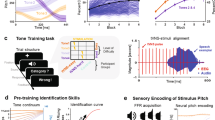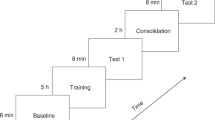Abstract
Three adult male baboons were trained on a psychophysical procedure to discriminate five synthetic, steady-state vowel sounds (/a/, /æ/, /ε/, /U/, and /⊃/) from one another. A pulsed train of one vowel comprised the reference stimulus during a session. Animals were trained to press a lever and release the lever only when this reference vowel sound changed to one of the comparison vowels. All animals learned the vowel discriminations rapidly and, once learned, performed the discriminations at the 95–100% correct level. The IM administration of diazepam (0.32, 1.0, 3.2, and 10.0 mg/kg) produced dose-dependent decrements in vowel discriminability. The diazepam-induced decrements in vowel discriminability were correlated with the degree of spectral frequency differences found among the different vowels, with lower vowel discriminability scores found for those vowels with smaller spectral differences from the reference vowel. In contrast, oral administration of Δ-9-THC (0.32, 1.0, 3.2, and 5.6 mg/kg) produced no decrements in vowel discriminability.
Similar content being viewed by others
References
Besser GM (1967) Auditory flutter fusion as a measure of the actions of centrally acting drugs: Modification of the threshold for fusion and the influence of adapting stimuli. Br J Pharmacol Chemother 30:329–340
Basser GM, Duncan C (1967) The time course of action of single doses of diazepam, chlorpromazine and some barbiturates as measured by auditory flutter fusion and visual fliicker fusion thresholds in man. Br J Pharmacol Chemother 30:341–348
Brady JV, Lukas SE (1984) Testing drugs for physical dependence potential and abuse liability. Natl Inst Drug Abuse Res Mono Ser 52. US Government Printing Office, Washington, DC
Burdick CK, Miller JD (1975) Speech perception by the chinchilla: discrimination of sustained /a/ and /i/. J Acoust Soc Am 58:415–427
Dewson JH III (1964) Speech sound discrimination by cats. Science 144:555–556
Dewson JH III, Pribram KH, Lynch JC (1969) Effects of ablations of temporal cortex upon speech sound discrimination in the monkey. Exp Neurol 24:579–591
Elsmore TF (1972) Effects of Δ-9-tetrahydrocannabinol on temporal and auditory discrimination performances of monkeys. Psychopharmacologia 26:62–72
Grove-White IG, Kelman GR (1971) Critical flicker frequency after small doses of methohexitone, diazepam and sodium 4-hydroxybutyrate. Br J Anaesth 43:110–112
Hedges A, Turner P, Harry TVA (1971) Preliminary studies on the central effects of lorazepam, a new benzodiazpine. J Clin Pharmacol 11:423–427
Hienz RD, Brady JV (1988) The acquisition of vowel discriminations by nonhuman primates. J Acoust Soc Am 84:186–194
Hienz RD, Lukas SE, Brady JV (1981) The effects of pentobarbital upon auditory and visual thresholds in the baboon. Pharmacol Biochem Behav 15:799–805
Hienz RD, Sachs MB, Sinnott JM (1981) Discrimination of steadystate vowels by blackbirds and pigeons. J Acoust Soc Am 70:699–706
Hienz RD, Turkkan JS, Harris AH (1982) Pure tone thresholds in the yellow baboon (Papio cynocephalus). Hearing Res 8:71–75
Hienz RD, Lukas SE, Brady JV (1985) Effects of d-methamphetamine upon auditory and visual reaction times and detection thresholds in the baboon. Psychopharmacology 85:476–482
Hoffer A, Osmond H (1967) The hallucionogens. Academic Press, New York
Jones RT (1980) Human effects: An overview. In: Petersen RC (ed). Marijuana Research Findings: 1980. Natl Inst Drug Abuse Res Mono Ser 31. US Goverment Printing Office Washington, DC
Klonoff H, Low MD (1974) Psychological and neurophysiological effects of marijuana in man: an interaction model. In: Miller LL (Ed.). Marijuana. Effects on human behavior. Academic Press, New York
Kuhl PK (1981) Discrimination of speech by nonhuman animals: basic auditory sensitivities conducive to the perception of speech-sound categories. J Acoust Soc Am 70:340–349
Kuhl PK, Miller JD (1978) Speech perception by the chinchilla: identification functions for synthetic VOT stimuli. J Acoust Soc Am 63:905–917
Light MH, Ferrell CJ, Sandberg RK (1977) The effects of sedation on the impedance test battery. Arch Otolaryngol 103:235–237
Lukas SE, Hienz RD, Brady JV (1985a) Effects of diazepam and triazolam on auditory and visual thresholds and reaction times in the baboon. Psychopharmacology 87:167–172
Lukas SE, Hienz RD, Brady JV (1985b) The effects of phencyclidine and ketamine on sensory thresholds and reaction times in the baboon. Pharmacol Biochem Behav 23:743–747
Malitz S, Kanzler M (1970) Effects of drugs on perception in man. Res Pub Assoc Res Nerv Ment Dis 48:35–53
Meyer RE (1978) Behavioral pharmacology of marijuana. In: Lipton MA, DiMascio A, Killam KF (Eds) Psychopharmacology: a generation of progress. Raven Press New York
Moskowitz H, McGlothlin W (1974) Effects of marihuana on auditory signal detection. Psychopharmacology 40:137–145
Ogle CW, Turner P, Markomihelakis H (1976) The effects of high doses of oxprenolol and of propranolol on pursuit rotor performance, reaction time, and critical flicker frequency. Psychopharmacologia 46:295–299
Petersen RC (1980) Marijuana and health: 1980, In: Petersen RC (ed) Marijuana Research Findings: 1980. Natl Inst Drug Abuse Res Mono Series 31. US Government Printing Office, Washington, DC
Petersen GE, Barney HL (1952) Control methods used in a study of the vowels. J Acoust Soc Am 24:175–184
Pols LCW, Tromp HRC, Plomp R (1973) Frequency analysis of Dutch vowels from 50 male speakers. J Acoust Soc Am 53:1093–1101
Sinnott JM, Beecher MD, Moody DB, Stebbins WC (1976) Speech sound discrimination by monkeys and humans. J Acoust Soc Am 60:687–695
Spreng M (1973) Artefact recongition and diazepam in electric response audiometry. Audiology 12:137–149
Stevens KN (1980) Acoustic correlates of some phonetic categories. J Acoust Soc Am 68:836–842
Waters RS, Wilson WA Jr (1976) Speech perception by rhesus monkeys: the voicing distinction in synthesized labial and velar stop consonants. Percept Psychophys 19:285–289
Author information
Authors and Affiliations
Rights and permissions
About this article
Cite this article
Hienz, R.D., Brady, J.V. Diazepam and Δ-9-THC: contrasting effects on the discrimination of speech sounds in nonhuman primates. Psychopharmacology 99, 261–269 (1989). https://doi.org/10.1007/BF00442820
Received:
Accepted:
Issue Date:
DOI: https://doi.org/10.1007/BF00442820




